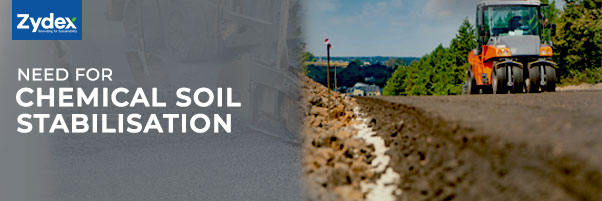Chemical Soil Stabilisation is the process of blending and mixing chemical additives to improve the engineering properties of the soil. The efficiency of the stabilisation depends on the reaction between the chemical/stabilizer used and the soil particle composition.
Soil stabilisation using chemical additives is adopted not only to arrest its shrinkage & swelling potential, but also to improve its strength, workability & durability, thus improving their overall performance. The increased performance implies reduced the maintenance costs, significantly improving the overall lifecycle costs of the pavement. It also offers other advantages such as reduced dusting requirements, controlled volume changes to soil and better workability.
The performance of the treated soil depends on the ability of the additives to react with the soil, which places a great emphasis on choosing the stabilizer best suited for a particular type of soil, taking into consideration, not only the improvement of its engineering properties but also considering its economic and environmental impact.
It has been a common practice to use calcium based stabilizers such as cement and lime for stabilisation, due to its notable effect of reduction in plasticity, swelling & shrinkage as well as the increased bearing strength. However, there are certain limitations to using these additives. Stabilisation of soils containing sulphate minerals when treated with lime, causes adverse chemical reactions & formation of an expansive crystalline mineral, causing heaving and other pavement distresses. Exposure of lime treated soils to wetting and drying cycles results in the loss of cohesion between soil and lime particles. Lime & cement applied in the powder form is known to burn unprotected workmen and also causes harmful environmental effects. Moreover, cement manufacturing emits large amounts of CO 2 . Fibers have been considered an effective alternative to help prevent cracks; however, its effectiveness in restricted to certain type of soils.
The use of bitumen emulsion for soil stabilisation is also a notable practice as it imparts water resistance to the soil particles, increases the load bearing capacity & stability of the soil. However, it may not be a cost effective solution as the soil particles require a high dosage of bitumen emulsion in order to provide the same/better level of bonding. Foamed bitumen, i.e. mixture of air, water and bitumen, is also being used for soil stabilisation. It has been proven that by applying foamed bitumen, produces a semi-rigid layer of stabilised soil.
New and emerging technologies such as enzymes and silanes are being preferred over traditional stabilisation methods, to solve the problems of swelling and shrinkage as well as to improve the load bearing capacity and compaction densities of poor soils, with no harmful effects on the environment. Major advantage of using chemical additives for soil stabilisation is that it enables the use of in- situ/locally available soils and aggregates. This decreases the effort and time required for hauling good quality materials from borrow areas, allowing for an efficient use of natural resources. This results in minimized cost of hauling, thereby reducing the cost of construction.







